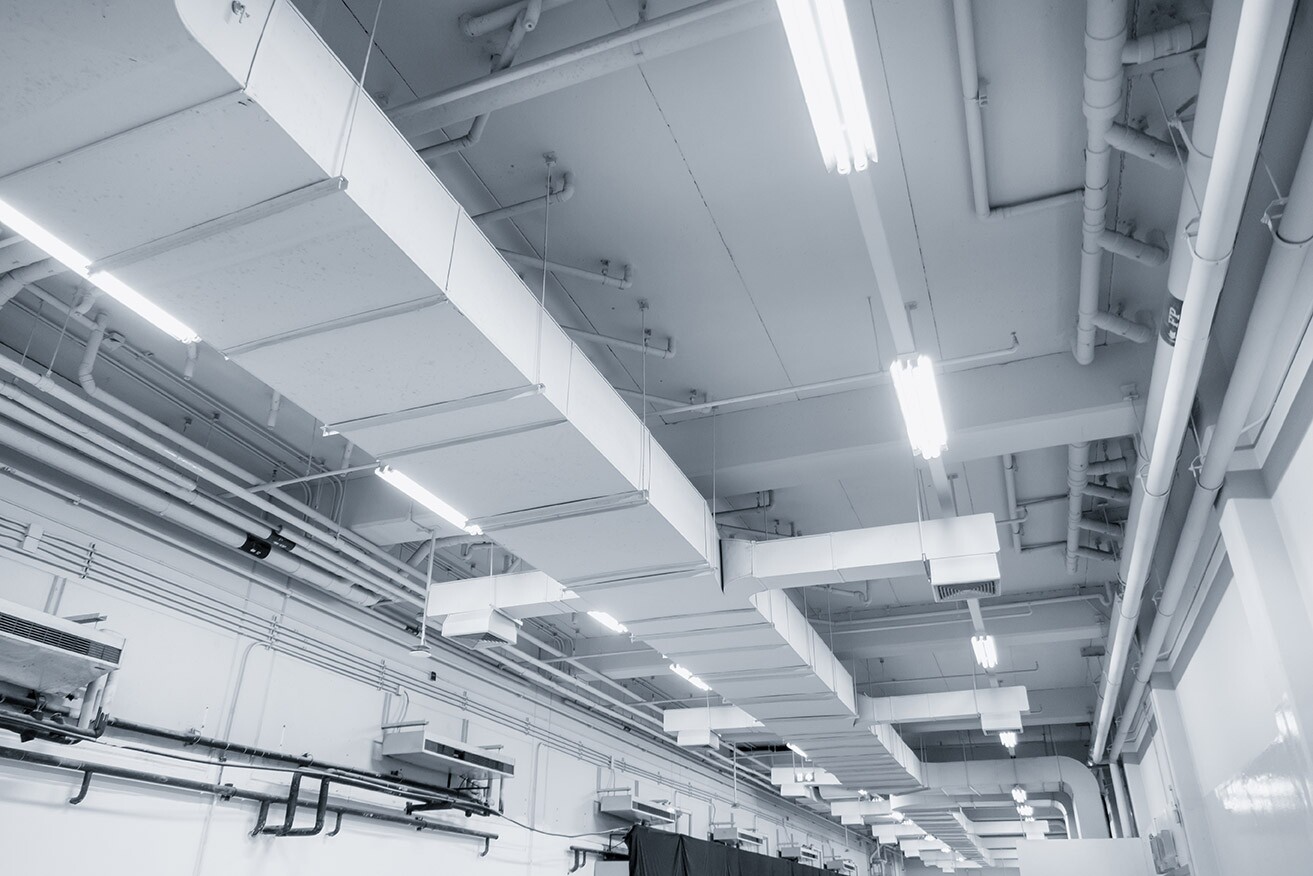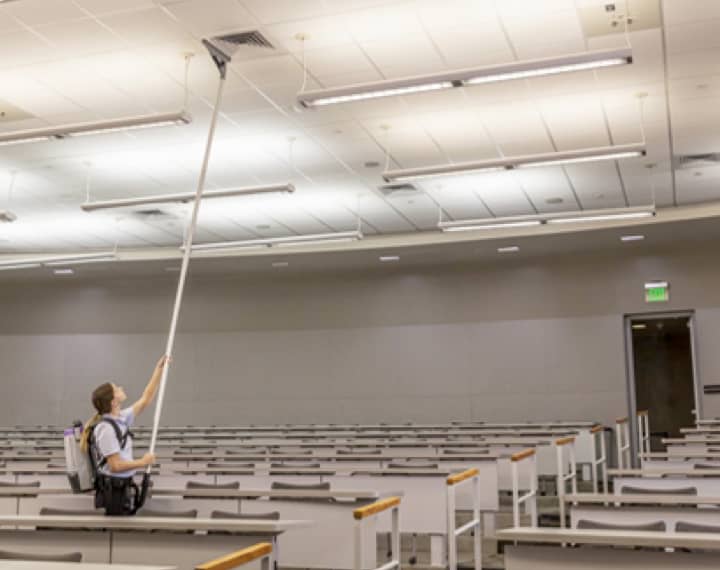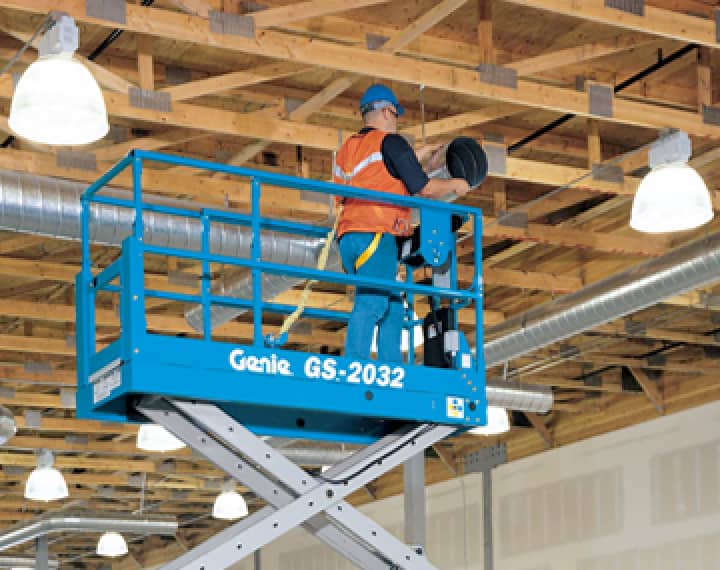Industrial and Commercial Ceiling Cleaning Services
The truth is that no one likes to clean their ceilings. Commercial and industrial ceiling cleaning is a tedious process that requires the use of specialized equipment, and when you're in charge of a facility that's 100,000 square feet or more, it can be an overwhelming task. The good news is there are some things you can do to make the process easier, faster, and safer so that you can meet OSHA compliance requirements for health and safety.

The Headache and Costs Associated with Special Tools, Equipment, and Training that are Required for Proper Ceiling Cleaning
Cleaning ceilings, rafters, and walls is an art form in itself. Special equipment such as ceiling tile cleaning ladders, scaffolds, or aerial lifts must be used to clean ceilings safely and effectively. For example, a large articulating aerial lift might be ideal to clean your ceiling rafters or ceiling tiles, but the shape or size of your facility will create too many obstacles. Large articulating aerial lifts may not be used in areas where there isn't enough room or the path to get to the area to clean might be too narrow. Because no two buildings are alike, we might have to use a combination of a ladder and a scaffold to clean the ceiling or rafters. For open areas we will likely use scissor lift because it is safer and faster, but our ceiling cleaning experts always find a way to clean safely and effectively. If your facility has different areas with different needs, purchasing your own equipment could be costly. The wrong tools can lead to injuries and costly lawsuits for your company if proper safety measures aren't taken during ceiling cleaning. The cost of hiring a professional to clean ceilings can seem high at first glance, but when you factor in lost time from employees being sick or hurt on the job due to unclean spaces, it becomes clear that this is actually one of the most affordable ways to keep your customers and employees healthy and safe.
Even with proper ceiling tile cleaning equipment, ceiling cleaning can still be incredibly tedious and time-consuming. A high-pressure washer to clean ceiling tiles would be a disaster. Have you considered if you are working with combustible dust? Most people don’t realize everyday products are actually considered combustible when they are in a fine dust. Cleaning ceiling tiles, rafters, and I-Beams requires teams to work at dangerous heights for long hours with swinging hoses and heavy buckets of water (and whatever chemicals are required). And this isn't even taking into account the planning that goes into ceiling tile cleaning; it's important not to disrupt business or cause any type of workplace disturbance, so scheduling commercial ceiling cleaning around your team's needs is key.
Proper ceiling cleaning and ceiling tile restoration involves using strong chemicals like bleach, ammonia, phenol carbolic acid (yes, that is a real thing), and other harsh chemicals. These can be dangerous if proper ceiling tile cleaning equipment isn't used, or if the ceiling tile cleaner doesn't follow all safety protocols.
Chemical exposure is very real, and ceiling cleaners who don't take these types of risks into account could end up hurting themselves or their colleagues. Injuries caused by neglecting to wear protective gear during commercial ceiling cleaning with chemicals can also lead to expensive medical bills for the ceiling cleaner's company , which is obviously not something any business wants to deal with.

Dust and Debris Falling During Ceiling and Rafter Cleaning
The worst thing about ceiling cleaning is that no matter how careful you are or how much you plan ahead, accidents are always possible. And if ceiling cleaners don't maintain proper safety standards while doing their job, they can end up causing more harm than good. For instance, ceiling dust falling onto light fixtures can cause them to short-circuit, which could lead to fires. Other examples of ceiling clean up mishaps include ceiling tiles being dropped on people below, ceiling crevices being missed (which reduces the effectiveness of your ceiling cleaning protocols), ceiling dust falling into food or drinks, ceiling dust coming out of light fixtures (this is an easy one to avoid by using a specialty vacuum system for commercial ceilings), and more.
If you or your company insists on having your in-house team perform ceiling cleaning, there are federal guidelines about ceiling cleaning safety that your team should be familiar with. They're included in OSHA ceiling cleaning standards, which are enforced across the country. It's also important to follow all state and local ceiling cleaning laws. If your team isn't familiar with how to mitigate safety issues and prevent the spread of dust and contaminants while cleaning, then it might be best to hire professional commercial ceiling cleaners to help put an ongoing ceiling cleaning protocol together. Failing to perform proper ceiling cleaning may actually cause your business to fail an OSHA safety inspection.
Professional cleaning services
for your building's ceilings
Want to keep your ceilings clean and dust free? Reach out to us today for advice or to book an appointment.
Cleaning the Ceiling: Fire Hazards and Risks
Industrial ceiling cleaning methods should be performed with care to mitigate the dangers of ceiling cleaning fire hazards. Improper cleaning of ceilings and rafters can release combustible ceiling dust into the air, which can lead to secondary explosions from exposed electrical equipment. The NFPA recommends that industrial ceiling cleaning is essential every six months for reducing ceiling-dust accumulation, especially near electrical components or mechanical systems. All work spaces should be properly ventilated and ceiling tiles and debris removed with dust containment (which means using vacuums and other tools that control spread of ceiling dust).
When choosing ceiling vacuums for ceiling tile cleaning, you should select one that is easy to maneuver and has a long hose. The hose length needs to be ample enough for ceiling tiles above walkways or office areas where people are walking around at floor level. Professional ceiling tile cleaners know that the longer the hose on your ceiling vacuum, the better chance they have at keeping debris off of light fixtures and other things below their work area. Vacuums must have HEPA filtration, but most importantly they should be Class II rated for combustible materials. If you are dealing with metallic combustible materials then the stakes get even higher. Not only should your vacuum system be Class II rated for combustible dust, but the attachments, extension poles, and the hose must also be Class II rated.
Proper Disposal of Ceiling and Rafter Dust and Debris
Industrial ceiling cleaning should also be performed by trained professionals who know how to properly dispose of ceiling tile debris and other hazardous waste materials they generate during their ceiling cleaning work. At a minimum, all ceiling clean up debris should be bagged and tagged for proper disposal. The ceiling cleaners responsible for removing the waste should have an adequate number of personal protection tools such as respirators, gloves, eye goggles or glasses, and protective clothing. If your team members can't meet these criteria (or if you're worried about legal liability), then hiring professional ceiling cleaners is your best bet.
Safe and Proper Removal of Ceiling Tiles to Avoid Damage and Injury
If ceiling tiles need to be removed for ceiling cleaning (or replacement), it's generally best to leave this task up to professional ceiling cleaners . The task of replacing ceiling tiles requires specialized tools and may entail working with ceiling grid systems that are usually attached directly to the building structure above, making them difficult and dangerous for untrained workers to disassemble and reassemble. Depending on how your ceiling tiles were fastened into place, you may not even have access to its underside once they're all taken down.
Industrial ceiling cleaners should also inspect drop ceiling tiles and ceiling grid systems to ensure that electrical wiring or other ceiling components are still intact. Removing ceiling tiles may cause ceiling fixtures such as lights and sprinklers to become loose, which can lead to hazards for people standing directly under them or cause serious damage that would be costly.
Picking the Right Cleaning Chemicals for Your Commercial Ceilings
Choosing the right cleaner for ceiling cleaning is critical. If you choose a commercial ceiling cleaner that damages your ceiling tiles, then they won't be able to provide the restoration services needed. This is especially important if your ceiling tiles are coated with urethane or another type of specialized coating that can only be cleaned by professionals who use specially-formulated chemicals.
In addition to ceiling tiles, ceiling panels should also be inspected. Ceiling panels are typically made from a lightweight material to help support ceiling tiles or ceiling grids. Depending on the material composition of the ceiling panel, these ceiling fixtures may require special treatment during ceiling cleaning and need to be handled with care.
Discount ceiling tile cleaners will often use harsh chemicals that strip the ceiling tiles of their finishes, causing them to turn hazy or discolored. Though this may seem like a quick fix, it actually damages ceiling tiles and can lead to costly re-coating services later on. Since some ceiling tile materials like acoustical ceiling tile (ACT) can be water-sensitive, always exercise caution when ceiling cleaning and follow safety precautions. It is important to maintain the acoustical value of ceiling tiles and the fire rating.
Commercial ceiling cleaners will inspect ceiling tiles and use their knowledge of ceiling finishes to determine whether the ceiling tiles can be cleaned, or if they need to be replaced. We have special recoating products that will maintain the acoustical value and the fire rating.
Once your ceiling tiles have been thoroughly cleaned with gentle cleansers, your ceilings should sparkle like never before, and you won't have to worry about hazardous chemicals and debris compromising the health of your employees. A clean ceiling is a happy ceiling.
In healthcare settings, ceiling cleaners must pay special attention to ceiling tiles that contain antimicrobial coating, which provide a safer work environment for patients and ceiling tiles that are coated with fungal-resistant materials.
Commercial Ceiling Cleaning Cadence
In case you were wondering, it is important to clean ceiling tiles and ceiling panels at least twice a year. Ceiling tiles that are frequently exposed to smoke, fumes or other contaminants should be cleaned as often as ceiling tiles that are darker in color and more visible.
If ceiling tiles and ceiling panels aren't properly maintained, they will show signs of wear and tear that can lead to costly replacement services or repairs.
Most experts recommend that commercial ceiling cleaners perform ceiling cleaning services every six months for ceilings that are only lightly dirty (such as those of offices) and every three months for more heavily-trafficked areas like hallways. Urethane-coated ceilings should generally be cleaned at least once per quarter since spills and other contaminants seem to stick to the surface quite easily, whereas acoustical ceiling tiles can be safely cleaned twice a year.
If ceiling tiles are not cleaned regularly, ceiling dirt can begin to discolor ceiling panels and ceiling tiles. Over time, ceiling stains will become difficult to remove and ceiling finishes could be stripped altogether by using harsh chemicals or repeating improper cleaning methods. If ceiling panels contain mold or other water damage that is not properly dried out, then the risk of toxic black mold developing in your ceiling system increases exponentially. The last thing you want is for an employee to discover a hidden health hazard during a routine office audit.

Commercial Ceiling Cleaners Aren't Just for Commercial Buildings
Hospitals, schools and other commercial buildings typically need several types of ceiling cleaning services including:
- General ceiling tile cleaning
- Urethane coating or acoustical ceiling treatment
- Historic restoration
- Stain removal
- Independent evaluations for Drywall repair
- Painting
- Metal ceiling tile cleaning
In healthcare settings, ceiling cleaners must also pay special attention to ceiling tiles that contain antimicrobial coating, which provide a safer work environment for patients and ceiling tiles that are coated with fungal-resistant materials.
If you have access to areas in your commercial building where ceiling tiles need general ceiling tile cleaning or drywall ceilings or walls need painting services , then it makes financial sense to hire a contractor with the knowledge and experience to clean ceilings and repaint ceilings when needed, instead of hiring separate contractors to do separate services at different times. Once you find a reliable contractor who can provide all of your ceiling restoration needs under one roof, then you'll be significantly reducing overhead costs while providing a more pleasant work environment for your employees.
In the end, every company needs to weigh the costs and safety risks before hiring or training employees to clean their own ceiling tiles. On one hand, paying professionals to do the job correctly can be costly. On the other hand, neglecting your ceiling cleaning duties can result in not only workplace accidents but you can also be fined for negligence.
For more information on the ceiling cleaning services that Spotless Cleaning Chicago provides, check out our High Dusting and Ceiling Cleaning page, or contact us today so that we can help you plan your ceiling cleaning!
